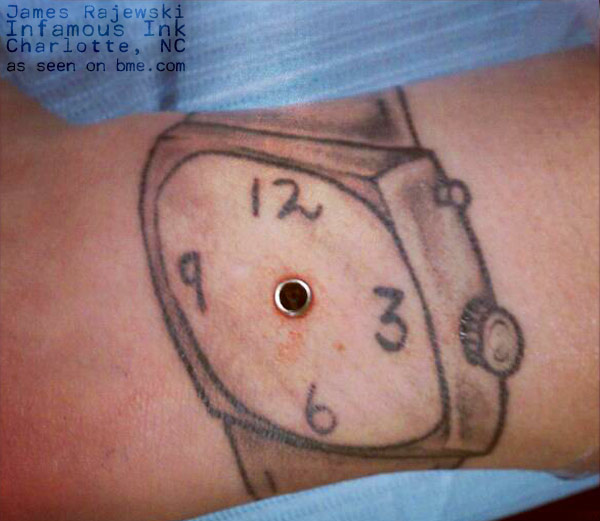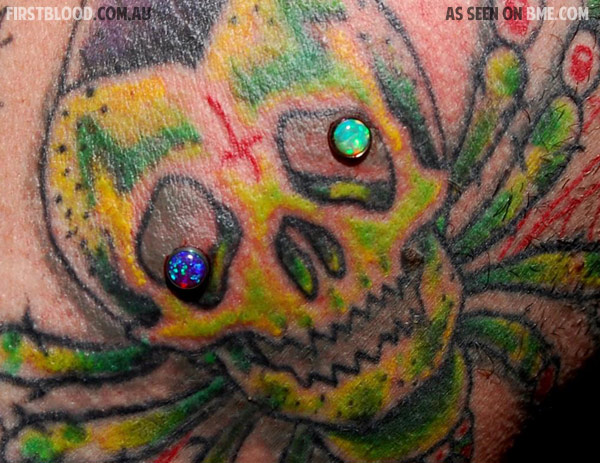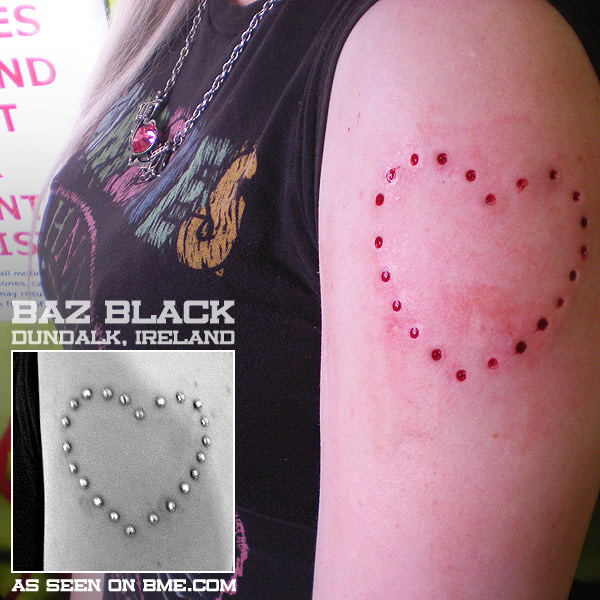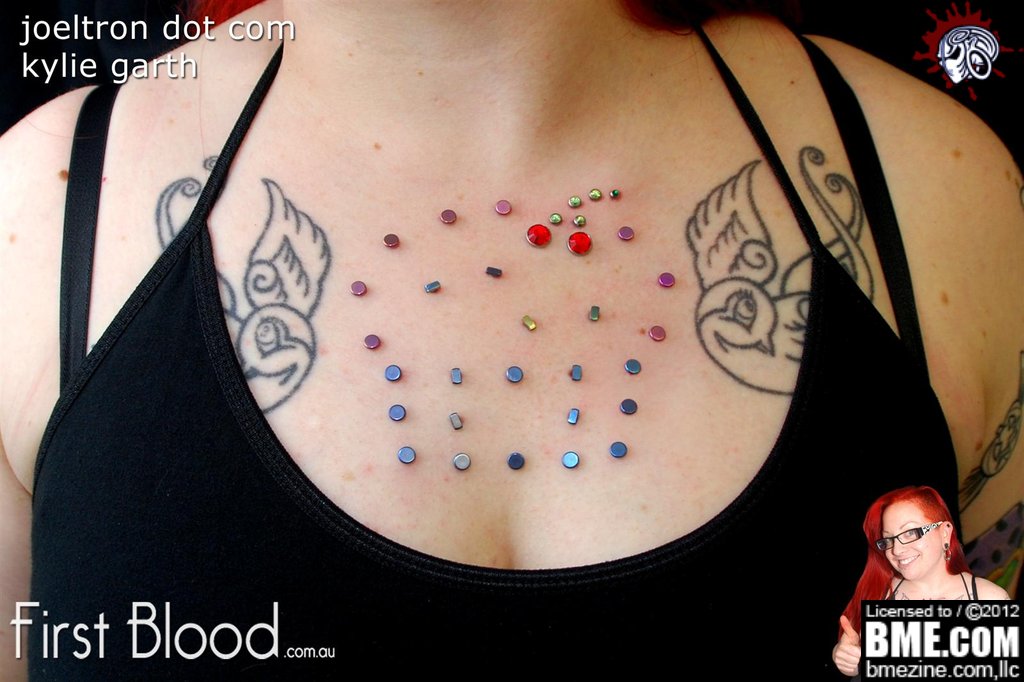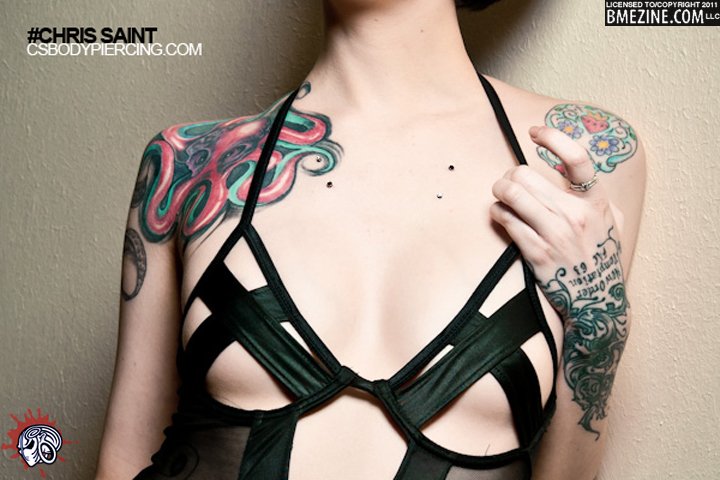I’ve been asked to update about my three experimental macrodermals, or “large gauge single-point pocketings”, that I’ve had on my leg for about seven months now if I remember right (although it might be less). Since I don’t think I’ve showed them on ModBlog before, let me quickly explain what they are and how and why I did them. First the “why”. About five years ago I had a large benign bone tumor removed from my right leg just below the knee. In the process of removing it, significant nerve damage was done to the leg, which had the side effect of making a portion of my leg on the inside of the calf starting just above the ankle, acutely painful and hypersensitive to touch, as well as causing it to be discoloured, have dry, scaly, scarred looking skin, and circulation problems leaving it feeling cold and dead. I really got to despise it — and with time and my subsequent genetic medical problems (unrelated to this issue), I have gotten to completely despise my body, which has become an enemy that cripples me and leaves me in great pain. One of the ways that I fight back against that is with body modification, because this gives me a sense of control, fulfillment, and perhaps even revenge, and makes me feel like I’m in control of my body again, rather than it being in control of me. The stranger and more exotic the modification the better. In addition, in the case of this particular part of my body, it had become physically ugly to me, and I wanted to reclaim it on that level as well. I know this modification isn’t beautiful or aesthetically ideal on any level, but it is a huge improvement in my eye and mind.
The jewelry itself is a bar that’s hair over 5/16″ (0ga) with a flare at the bottom (the part that’s under the skin) about 3/32″ of radius past the main body of the bar, sort of like a flat-backed labret stud. The tops are all slightly different “cap” designs which are a single-piece with the rest of the jewelry (ie. they’re not removable or changeable without swapping the entire jewelry). The whole jewelry is hand carved by me out of solid aluminum using my Dremel and then polished — this is a time consuming process that makes me miss having a lathe! I chose to do it in aluminum not just because it is an inert metal often used for medical implants (that whole Alzheimer thing was disproved long ago, so please don’t bring it up!), but because it was light. I actually started the piercing using silicone jewelry of a similar design, but I found it wasn’t healing as well as I’d hoped so I switched materials and it instantly accelerated the healing process.
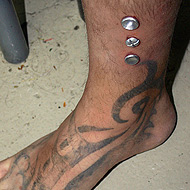
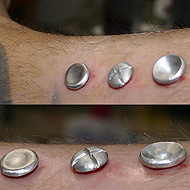
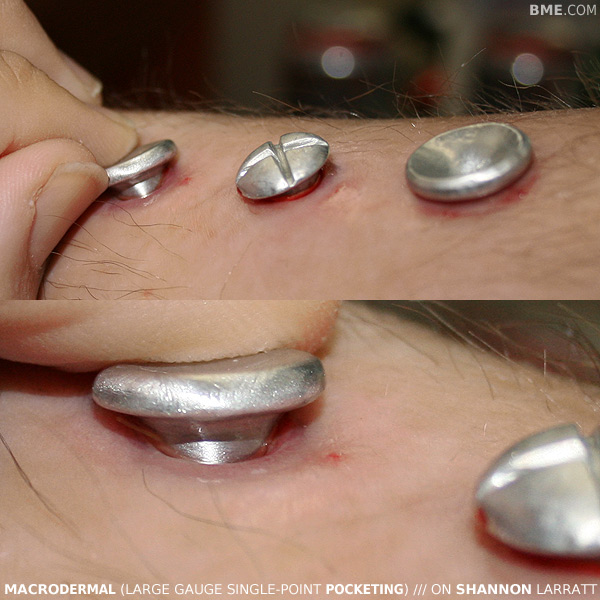
The procedure itself is not something I’d recommend, but I will document it for you nonetheless. I began by making an incision using a #11 scalpel, into which I pushed a sharpened piece of bamboo perhaps 1/8″ in diameter at its widest point. I held it in place using a first-aid-style pressure dressing, which caused the skewer to sink into the flesh of my leg. Because the body’s reaction was to respond as if it was a skewer, the flesh withdrew slightly and lightly lubricated the wound — without the pressure dressing, the wood would pop right out. Over 48 hours, I quickly increased the size of the skewers until I was at my final size and depth. This was a completely bloodless procedure and relatively pain-free other than the initial incision. Once the hole was at size, I pushed in the initial jewelry, which as I said, was silicone. The advantage of the silicone jewelry was that it was easy to take in and out to examine the healing, and also that the footing compressed as it was inserted and did not traumatize the narrower entrance hole. However, I found that while the body adapted to having the silicone jewelry in place, that it wasn’t truly healing. When I switched to the aluminum jewelry, the healing to a more traditional piercing fistula sped up.
At this point I’ve been wearing the aluminum jewelry for almost two months I think, and they’re well on their way to being completely healed. I had a bit of a set-back after spending two days in a lake without proper cleaning, but it’s fine now. These pictures were taken today. There is minor lymph discharge, but no blood or pus or problematic discharge, nor is there any redness, swelling, or other sign of difficulty. The jewelry is quite solidly in place and, unlike the earlier silicone jewelry, I never remove it. I suspect I could with enough force but I haven’t wanted to risk damaging them. The piercings are comfortable, totally pain-free, and rotate freely and easily in the holes. The entrance holes look very healthy to me, even though the aftercare and cleaning regiment has been woefully dismal and non-existent. Because it’s very painful and difficult for me to get into the shower, both because of my muscle damage and how painful the contact with the water is on my skin (nothing to do with the piercing), I only clean it with soap and water every few days. It has however been extremely tolerant of this.
This is not something I’d recommend anyone replicate as there are probably better ways to create large gauge single-point piercings than the method I’m using here. That said, I hope this is of interest to anyone with a taste for unusual procedures and DIY body experimentation.
